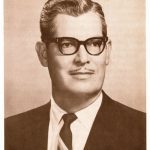CIVIL WAR HERO—First Medal of Honor Recipient
By Dr. Lorin Swinehart
At first glance, Jacob Parrot would not have impressed many people as a national hero. He appears in photos as a pale, thin young man sporting a dark mustache and with something of a haunted look in his eyes. A farm boy from near Lancaster, Ohio, he was orphaned at an early age. Little more is known about him, except that he relocated to Kenton, Ohio, until he enlisted in 1861 at the age of eighteen in the U.S. Army as a private in Company K of the 33d Ohio Infantry. He first saw combat during the little known Battle of Ivy Hill.
In April, 1862, he was asked by his commanding officer if he would be willing to volunteer for a highly secret and very dangerous mission behind enemy lines. Parrot agreed and became one of a group of twenty soldiers and two civilians recruited for a daring raid into the heart of the Confederacy. The group, known as Andrews’ Raiders, was to carry out a plan hatched by General Ormsby MacKnight to infiltrate behind rebel lines and hijack a locomotive known as The General near Big Shanty, Georgia. Led by their commander James J. Andrews, they would then destroy all bridges between Atlanta, Georgia and Chattanooga, Tennessee, thus cutting off the supply route of the Confederate Army.
Penetrating two hundred miles into the heart of the Old South, the unit succeeded in grabbing the train and leading their pursuers on a merry chase through Georgia, an escapade that was later to become the subject of several books and a Walt Disney movie entitled The Great Locomotive Chase. The mission was basically a failure because the unit was able to do little damage before being stopped by the enemy. Realizing that they were about to be captured, Parrot and a companion fled into a nearby woods.
Eventually leaving the protection of the trees and brush, they were captured by four Georgians and taken to a company of Confederate soldiers in the town of Ringgold. There they were interrogated by an officer. When Parrot refused to answer questions about his fellow soldiers or their mission, he was taken outside, where his shirt was removed. He was then bent over a stone and given over one hundred lashes with a rawhide whip.
Throughout this brutal treatment, two pistols were held at his head, and he was told that he would be shot if he resisted. Three times, the flogging was stopped and the officer, a lieutenant, demanded that he cooperate. Each time, he refused to provide any information. Meanwhile, a crowd of civilians gathered carrying a rope, demanding that he be hanged.
Only the intervention of a colonel saved him. It has been speculated since that Parrot, only nineteen at the time, was singled out for this torture because he was the youngest member of the unit and, therefore, considered most likely to break under pressure.
The ordeal of Parrot and his comrades was not over. They were taken to a jail in Chattanooga and left in a hot, cramped, dark filthy room, handcuffed together and with trace chains padlocked around their necks. Parrot’s own words testify to the horrible conditions of their imprisonment, “We had scarcely any light at all. Frequently, we could not see to pick up a pin from the floor. The windows were very small, and the room was so close, and we were so warm, that we had to take our clothes off entirely. We were covered with vermin. The room was so small that we could not all lie down, and we had to rest ourselves by leaning against the walls. We were not allowed to leave the room under any circumstances while we were confined in it.”
One can only imagine the discomfort of Parrot, his back still sore from the flogging. Weeks later, when debriefed by Union officials, he testified that his back was still sore. The meager rations provided by their captors could only have aggravated his condition. According to Parrot, they were only given some wheat flour mixed with water and then baked and a very small ration of spoiled pickled beef. He received no medical treatment for his wounds until he reached Richmond, where a physician applied some mustard plasters.
On March 25, 1863, shortly after being exchanged for some Confederate prisoners held by the Union, Parrot and five other raiders were taken to Washington, D.C., where Secretary of War Edwin Stanton told them, “You’ll find yourselves great heroes when you get home.”
Impressed by Parrot’s youth and his good manners, Stanton presented him with the first ever Medal of Honor, saying, “Congress has by recent law ordered medals to be prepared on this model, and your party shall be the first to be given to private soldiers in the war.”
Jacob Parrot was offered many honors, even an education at West Point, but he opted to return to the war. He took part in many actions and was commissioned a second lieutenant in 1863, following his participation in the Battle of Stones River. In 1864, he was promoted to first lieutenant.
After the war, Parrot returned to Kenton, where, in 1866, he married Sarah Lawrence, a local girl, and spent the remainder of his days as a cabinet maker. He passed away on March 25, 1908 from a bout with angina pectoris and is buried in the Grove Cemetery in Kenton. A road in Hardin County is named Jacob Parrot Boulevard in his honor. In 1990, Jacob Parrot’s heirs returned his Medal of Honor to Congress, and it is now on display in the rotunda of the U.S. Capitol in Washington.
- April 2024 – Issue - March 31, 2024
- April 2024 – Articles - March 31, 2024
- April 2024 - March 31, 2024









